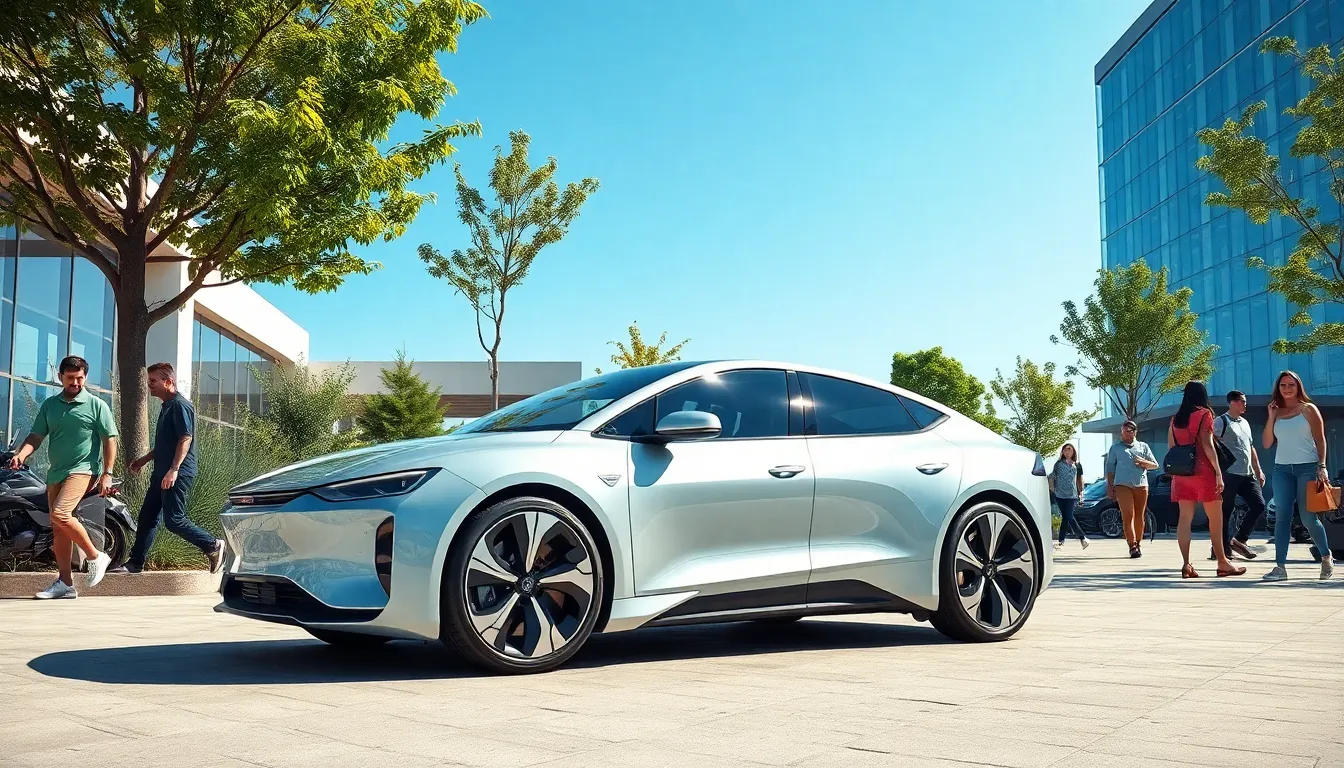As the world shifts toward sustainability, energy-efficient cars are taking center stage in the automotive industry. These vehicles not only reduce fuel consumption but also help lower greenhouse gas emissions, making them a smart choice for eco-conscious drivers. With advancements in technology, manufacturers are racing to produce cars that maximize efficiency without sacrificing performance.
Drivers today are more informed than ever about the impact of their choices on the environment. Energy-efficient cars offer a practical solution, combining cost savings with environmental benefits. From hybrids to fully electric models, these vehicles cater to a variety of needs and lifestyles. Embracing energy-efficient cars isn’t just a trend; it’s a step toward a cleaner, greener future.
Table of Contents
ToggleOverview of Energy-Efficient Cars
Energy-efficient cars prioritize reduced fuel consumption and minimized environmental impact. These vehicles utilize advanced technologies, such as hybrid powertrains and fully electric systems, to enhance performance while lowering emissions.
Types of Energy-Efficient Cars:
- Hybrid Cars: Combine traditional gasoline engines with electric motors, improving fuel economy and lowering emissions.
- Plug-in Hybrid Cars: Feature larger batteries compared to standard hybrids, allowing for extended electric-only driving ranges before reverting to gasoline.
- Electric Vehicles (EVs): Rely exclusively on electric power, producing zero tailpipe emissions and requiring no gasoline.
- Fuel Cell Vehicles (FCVs): Use hydrogen and oxygen to generate electricity, emitting only water vapor as a byproduct.
Benefits of Energy-Efficient Cars:
- Cost Savings: Lower fuel expenses result from decreased fuel consumption and tax incentives in many regions.
- Reduced Emissions: Significant reductions in CO2 emissions help combat climate change.
- Increased Energy Security: Energy-efficient cars reduce reliance on fossil fuels, contributing to improved energy independence.
- Quiet Operation: Electric and hybrid cars operate more quietly than traditional vehicles, reducing noise pollution.
Energy-efficient cars represent a significant shift in automotive design, blending performance with sustainability. As technology advances, many manufacturers seek to enhance the effectiveness of these vehicles, ensuring they remain appealing to consumers focused on environmental responsibility.
Benefits of Energy-Efficient Cars

Energy-efficient cars provide numerous benefits, significantly impacting both the environment and the economy. These advantages make them a smart choice for drivers looking to contribute to a sustainable future while also enjoying financial perks.
Environmental Impact
Energy-efficient cars significantly reduce greenhouse gas emissions, helping to combat climate change. For instance, electric vehicles (EVs) produce zero tailpipe emissions, cutting air pollutants and improving overall air quality in urban areas. Hybrid cars utilize advanced powertrains that lower fuel consumption and diminish carbon dioxide (CO2) emissions compared to conventional vehicles. Additionally, these cars contribute to diminished reliance on fossil fuels, supporting energy independence and promoting renewable energy sources.
Economic Advantages
Energy-efficient cars offer compelling economic benefits. Lower fuel expenses translate into substantial savings over time, especially for drivers with long commutes. For example, hybrid cars can achieve an average of 50 miles per gallon (mpg), significantly reducing fuel costs. Various jurisdictions also provide tax incentives and rebates for purchasing energy-efficient vehicles, making them financially attractive. Furthermore, energy-efficient cars often require less maintenance, as they have fewer moving parts compared to traditional internal combustion engine vehicles, resulting in additional cost savings for owners.
Types of Energy-Efficient Cars
Energy-efficient cars fall into several distinct categories, each providing specific advantages. Understanding these types helps drivers choose the best option for their needs.
Hybrid Vehicles
Hybrid vehicles combine gasoline engines with electric motors to improve fuel efficiency. They seamlessly switch between the two power sources based on driving conditions. Hybrids typically achieve an average of 50 miles per gallon, significantly reducing fuel costs and greenhouse gas emissions. Benefits include reduced reliance on fossil fuels and lower CO2 emissions compared to conventional gasoline cars. Popular hybrid models include the Toyota Prius and Honda Insight.
Electric Vehicles
Electric vehicles (EVs) operate entirely on electricity, utilizing rechargeable batteries. These vehicles produce zero tailpipe emissions, promoting cleaner air and reducing overall environmental impact. EVs often offer impressive acceleration and low operating costs, with many models boasting a range of over 250 miles on a single charge. Tax incentives and rebates often accompany the purchase of new EVs. Notable examples include the Tesla Model 3 and Nissan Leaf.
Plug-in Hybrid Vehicles
Plug-in hybrid vehicles (PHEVs) feature both gasoline engines and electric motors, but they can be charged through a power outlet. This design allows for greater electric-only range, usually between 20 to 50 miles, before the gasoline engine activates. PHEVs offer flexibility for long-distance travel without range anxiety. They provide fuel savings and reduced emissions similar to regular hybrids. Popular PHEV models include the Chevrolet Volt and Toyota RAV4 Hybrid.
Key Features to Consider
Choosing an energy-efficient car involves evaluating several key features that significantly influence performance, safety, and technology.
Fuel Efficiency
Fuel efficiency remains a crucial determinant when selecting an energy-efficient vehicle. Hybrid cars typically achieve around 50 miles per gallon, while fully electric vehicles (EVs) eliminate fuel consumption altogether. Plug-in hybrids offer flexibility with electric-only ranges between 20 to 50 miles, allowing drivers to utilize electricity for shorter trips. Fuel efficiency translates directly into cost savings, making it essential to check official EPA ratings and real-world performance reviews to gauge a car’s effectiveness.
Safety Ratings
Safety ratings provide vital insights into a vehicle’s crashworthiness and reliability. Energy-efficient vehicles often come equipped with advanced safety features designed to protect occupants and prevent accidents. Organizations like the National Highway Traffic Safety Administration (NHTSA) and the Insurance Institute for Highway Safety (IIHS) assess safety performance, awarding ratings based on rigorous testing. High safety ratings enhance peace of mind and reflect a commitment to driver and passenger protection.
Technology Integration
Technology integration enhances the driving experience and optimizes energy efficiency. Many energy-efficient cars include features like regenerative braking, which captures energy during braking to recharge the battery. Additionally, infotainment systems with smartphone connectivity improve convenience and accessibility. Advanced driver-assistance systems (ADAS), equipped in modern vehicles, provide features such as adaptive cruise control, lane-keeping assistance, and collision avoidance. Evaluating the technology offered enhances the overall value of energy-efficient cars, making them more appealing in today’s market.
Energy-efficient cars are more than just a trend; they represent a pivotal shift towards sustainable driving. By choosing these vehicles, drivers not only contribute to a healthier planet but also enjoy significant savings on fuel and maintenance costs. With advancements in technology, the options available today cater to various needs and preferences, ensuring that performance doesn’t take a backseat to efficiency.
As awareness grows about the environmental impact of traditional vehicles, the adoption of energy-efficient cars is likely to increase, paving the way for a cleaner and greener future. Embracing this change is essential for those who want to lead the way in responsible driving while enjoying the benefits of modern automotive innovations.



